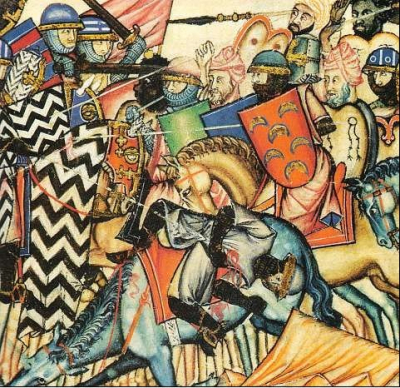The siege of Algeciras was the first of many sieges of the city by Christian forces in the lengthy period of the Spanish Reconquista. The siege, ordered by King Alfonso X of Castile also known as "el Sabio", was a fruitless military campaign initiated by the Kingdom of Castile with the objective of removing the Benimerins from Algeciras. The siege on Algeciras, then known to the Muslims as Al-Jazira Al-Khadra, was strategically important because Algeciras had been at the time the main fortress and landing place for African reinforcement troops in the Iberian Peninsula. Castile, which had a powerful armada of ships anchored in the Bay of Gibraltar to blockade such reinforcement, had a few days previously to the siege, seen that fleet obliterated by the Muslim admiral, Abu Yusuf Yaqub at the Naval Battle of Algeciras.
The Reconquista (Portuguese and Spanish for "reconquest") was a period in the history of the Iberian Peninsula of about 781 years of war between Spanish Christians and Muslims between the Umayyad conquest of Hispania in 711, the expansion of the Christian kingdoms throughout Hispania, and the fall of the Nasrid kingdom of Granada in 1492.
The beginning of the Reconquista is traditionally marked with the Battle of Covadonga (718 or 722), the first known victory in Hispania by Christian military forces since the 711 military invasion undertaken by combined Arab-Berber forces. The rebellion led by Pelagius defeated a Muslim army in the mountains of northern Hispania and established the independent Christian Kingdom of Asturias.In the late 10th century, the Umayyad vizier Almanzor waged military campaigns for 30 years to subjugate the northern Christian kingdoms. His armies ravaged the north, even sacking the great Santiago de Compostela Cathedral. When the government of Córdoba disintegrated in the early 11th century, a series of petty successor states known as taifas emerged. The northern kingdoms took advantage of this situation and struck deep into al-Andalus; they fostered civil war, intimidated the weakened taifas, and made them pay large tributes (parias) for "protection".
After a Muslim resurgence in the 12th century, the great Moorish strongholds in the south fell to Christian forces in the 13th century after the decisive battle of Navas de Tolosa (1212)—Córdoba in 1236 and Seville in 1248—leaving only the Muslim enclave of Granada as a tributary state in the south. After 1492, the entire peninsula was controlled by Christian rulers. The conquest was followed by a series of edicts (1499–1526) which forced the conversions of Muslims in Spain, who were later expelled from the Iberian peninsula by the decrees of King Philip III in 1609. Likewise, on 30 July 1492, all the Jewish community – some 200,000 people – were forcibly expelled.
Beginning in the 19th century, traditional historiography has used the term Reconquista for what was earlier thought of as a restoration of the Visigothic Kingdom over conquered territories. The concept of Reconquista, consolidated in Spanish historiography in the second half of the 19th century, was associated with the development of a Spanish national identity, emphasizing nationalistic and romantic aspects.

 English
English  español
español  français
français  português
português  русский
русский  العربية
العربية  简体中文
简体中文 
